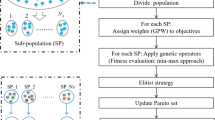Abstract
Best-First search is a problem solving paradigm that allows to design exact or admissible algorithms. In this paper, we confront the Job Shop Scheduling problem with total flow time minimization by means of the A * algorithm. We devised a heuristic from a problem relaxation that relies on computing Jackson’s preemptive schedules. In order to reduce the effective search space, we formalized a method for pruning nodes based on dominance relations and established a rule to apply this method efficiently during the search. By means of experimental study, we show that the proposed method is more efficient than a genetic algorithm in solving instances with 10 jobs and 5 machines and that pruning by dominance allows A * to reach optimal schedules, while these instances are not solved by A * otherwise. These experiments have also made it clear that the Job Shop Scheduling problem with total flow time minimization is harder to solve than the same problem with makespan minimization.
Similar content being viewed by others
References
Bierwirth C. (1995) A generalized permutation approach to jobshop scheduling with genetic algorithms. OR Spectrum 17: 87–92
Blazewicz, J., Ecker, K.~H., Pesch, E., Schmidt, G., & Werglarz, J. (1996). Scheduling computer and manufacturing processes. Springer.
Brucker, P. (2004). Scheduling algorithms (4th edn.). Springer.
Brucker P., Jurisch B., Sievers B. (1994) A branch and bound algorithm for the job-shop scheduling problem. Discrete Applied Mathematics, 49: 107–127
Brucker, P., & Knust, S. (2006). Complex scheduling. Springer.
Carlier J., Pinson E. (1989) An algorithm for solving the job-shop problem. Management Science 35(2): 164–176
Carlier J., Pinson E. (1994) Adjustment of heads and tails for the job-shop problem. European Journal of Operational Research, 78: 146–161
Dell’ Amico M., Trubian M. (1993) Applying Tabu search to the job-shop scheduling problem. Annals of Operational Research, 41: 231–252
Giffler B., Thomson G. L. (1960) Algorithms for solving production scheduling problems. Operations Research 8: 487–503
González M.A., Sierra M., Vela C.R., Varela R. (2006) Genetic algorithms hybridized with greedy algorithms and local search over the spaces of active and semi-active schedules. Lecture Notes in Computer Science, 4177: 231–240
Hart P., Nilsson N., Raphael B. (1968) A formal basis for the heuristic determination of minimum cost paths. IEEE Transactions on Systems, Science and Cybernetics 4(2): 100–107
Kreipl S. (2000) A large step rendom walk for minimizing total weighted tardiness in a job shop. Journal of Scheduling, 3: 125–138
Mattfeld D.C. (1995). Evolutionary search and the job shop investigations on genetic algorithms for production scheduling. Springer-Verlag.
Nilsson N. (1980) Principles of artificial intelligence. Tioga, Palo Alto, CA
Nowicki E., Smutnicki C. (1996) A fast taboo search algorithm for the job shop scheduling problem. Management Science, 42: 797–813
Pearl, J. (1984). Heuristics: Intelligent search strategies for computer problem solving. Addison-Wesley.
Sadeh N., Fox M.S. (1996) Variable and value ordering heuristics for the job shop scheduling constraint satisfaction problem. Artificial Intelligence 86: 1–41
Sierra, M., & Varela, R. (2005). Optimal scheduling with heuristic best first search. In Proceedings of AI*IA’2005, Lecture Notes in Computer Science, Vol. 3673, pp. 173–176.
Sierra, M., & Varela, R. (2007). Pruning by dominance in best-first search. In Proceedings of CAEPIA’2007, Vol. 2, pp. 289–298.
Varela R., Soto E. (2002) Sheduling as heuristic search with state space reduction. Lecture Notes in Computer Science 2527: 815–824
Yamada, T., & Nakano, R. (1996). Scheduling by genetic local search with multi-step crossover. In Proceedings of Fourth International Conference On Parallel Problem Solving from Nature (PPSN IV 1996), pp. 960–969.
Zhang C.Y., Li P., Rao Y., Guan Z. (2008) A very fast ts/sa algorithm for the job shop scheduling problem. Computers and Operations Research 35: 282–294
Author information
Authors and Affiliations
Corresponding author
Rights and permissions
About this article
Cite this article
Sierra, M.R., Varela, R. Pruning by dominance in best-first search for the job shop Scheduling problem with total flow time. J Intell Manuf 21, 111–119 (2010). https://doi.org/10.1007/s10845-008-0167-4
Received:
Accepted:
Published:
Issue Date:
DOI: https://doi.org/10.1007/s10845-008-0167-4




